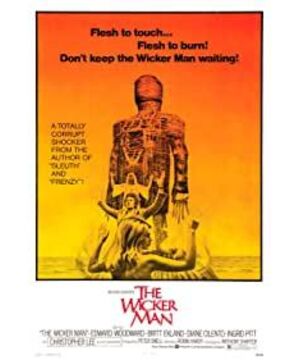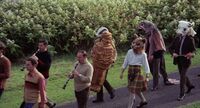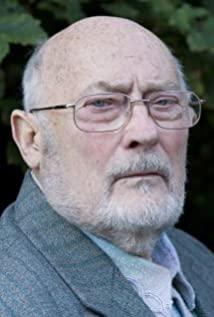As a classic of "cult" horror movies, the 1973 version of "Hearts" "grafted" the bonfire ceremony popular in the Scottish Highlands during the pre-Christian era into the 20th century in a weird but mysterious way. On an isolated island in the 1970s.
In the 1970s, a Christian police officer received a letter asking him to come to Summer Island, a small island on the west coast of Scotland, to investigate a girl who had been missing for a long time. The police officer came to Xia Island to investigate, but found that the atmosphere on the island was very strange. As the investigation progressed, the police officers then discovered that the residents of the island were a group of pagans who did not believe in Christ, and there was a tradition of living sacrifices in the "May Festival". At the end of the movie, the police officer was burned among the wicker men as a "sacrifice".
As an artistically created film, its text composition seems to interpret the primitiveness and absurdity of paganism from the perspective of Christianity, presenting a pagan system that is difficult to be self-consistent in its belief system and has no foundation. But if we analyze the witchcraft in the movie with an anthropological method, it is indeed not without a trace. From the perspective of anthropological research, we can roughly understand the origin, meaning and process of religion and witchcraft hidden behind the movie.
1. Faith and life and death
The worship of natural gods is the main worship object of "Xiadao". The banner of "Xiadao" is printed with a yellow sun with a face, which is the "Almighty Sun God". When the crops were not harvested and living people needed sacrifices, the objects offered by the lord of "Xiadao" were the gods of the sun and the orchard. Reproductive worship is quite common on "Xiadao". At night, police officers walked on the road and saw young men and women having group sex in the grass. Children in the school will sing songs about reproductive worship. In terms of the destiny of the soul, it is different from the Christian rebirth after death, but reincarnation. Once life is over, the soul will return to trees, air, fire, water, and animals to reappear in another form of life.
(1), the god of the sun and the orchard
God originated from the theory of animism, and primitive people regarded life as having a body and soul. After observing the two phenomena of living things, they formed a concept of something different from the body, that is, the concept of soul. Through the phenomena of sleep, trance, disease, and death, primitive people think that the body is more or less abandoned by some power, leaving only a lonely body. The phenomenon of dreaming and fantasy seems to be this invisible force-the soul has entered a state of independent existence.
In the thinking of primitive people, they regard the existence of self as the standard of all other existence, that is, they extend their personal conclusions to the nature of other things. As a result, people at that time thought that everything else, including various natural substances, also contained two parts of body and soul.
Animism does not regard all things as objects of worship. Primitives have a choice in worshiping gods. Although they believe in old gods, when crops fail, out of utilitarian considerations, they choose the sun. As the object of its worship. The worship of "Xiadao" for the sun god is often based on the worship of the agricultural god. In the process of agricultural production, primitive people gradually discovered the inner relationship between "the sky" and the production of crops. Apologize has a huge impact. Too much or too little sunshine will affect the harvest of crops. The growth of crops does not depend on people but on the sky, so they transplanted the animism to the sky, and they worshipped the celestial gods, especially the worship of the sun that gives the crops warmth.
According to this concept, the worship of the god of plants should also differentiate into the corresponding "God of Apple" and "God of Banana". However, on the "Xiadao", there is a more powerful orchard that controls everything. The god. In other words, polytheism has emerged on top of traditional pantheism. People no longer regard each plant as a conscious life body, but as an inanimate and inactive object. Above them, there is a supernatural life that can freely come and go among plants, dominate or occupy plants, and use them as a residence. This supernatural life is no longer dependent on plants, but controls and governs the plants themselves. He No longer the god of plants but the god of orchards.
(2) Reproductive worship and tree
In the school on "Xiadao", there was a scene of a tree trunk whose branches and leaves were cut off. The boy climbed to the top by stepping on the dendrites and placed the grass ring formed by the branches and leaves on top of it. Others wore red or white ribbons around their waists, and the other end of the ribbon was connected to the top of the tree. They circled the tree. Accompanied by the music of bouzuki, violin, whistle and elbow bagpipe, the teacher hummed a folk song: There is a trunk on the tree, a branch on the branch, a nest on the branch, an egg in the nest, and an egg in the egg. There is a bird. There is a board on the bird, and that board is a bed. There is a girl on the bed, a man on the girl, a mat on the man, a child on the mat, a man on the child, a cemetery on the man, and a tree on the grave.
The dendrites with their branches and leaves removed are considered to be a symbol of reproduction. The boys touch it with their hands in the hope of gaining strong reproductive ability. This applies to the use of sympathetic witchcraft. The thinking mode of witchcraft is an associative abstract principle that connects two unrelated things with a certain commonality, and affects the other by influencing one thing. Things. According to "similarity" and "contact", sympathetic witchcraft can be divided into homeopathic witchcraft (law of similarity) and contact witchcraft (law of contact). Homeopathic witchcraft is to treat things that are similar to each other as one thing; contact witchcraft is to treat things that have been in contact with each other as always in contact.
According to the witchcraft principle of the law of similarity, the dendrites that have faded branches and leaves are given the meaning of reproduction and reproduction as things that look like a penis. The boy stepping on the dendrites and placing the grass ring on the top of the tree is also a simulating scene of intercourse, through which the child gains the ability to reproduce through the tree. The tree itself is also used as the foundation of life, from the tree to the human. The metaphor of the tree, the bird and the human implied the cycle of the soul. The tree breeds the bird, the bird transforms into a human, and after the death of the human, it provides the tree with nourishment for its growth. The tree is both the beginning and the end.
Another manifestation of reproductive worship is the outdoor group sex between men and women before the "May Festival". Regarding the reason for group sex, we can understand that they personify the ability of plants as males and females. The relationship between the sexes has an inductive effect on plants. According to the principle of homeopathy or simulated witchcraft, men and women on the grass in the wild are just like plants in the wild. The intermingling of the two sexes acquires the ability to reproduce, and at the same time acts in the celebration to promote the growth of flowers and trees.
(3) The home of the soul
In the folk songs sung by the teacher, besides the concept of reproduction, another important concept is the cycle of life. The animism mentioned earlier, since all things in nature have souls, souls can communicate with people, so the soul after death circulates among all things in the world.
The Druidism believed by the ancient Celts believed that the souls of the dead would not descend to the lonely land at the junction of yin and yang, nor to the dark realm deep underground. On the contrary, the same breath would be in a different place. Still control this body. "Another different place" is the opposite of "Lonely Land" and "Dark Country". The afterlife is a better world than this life.
In Irish literature, "the afterlife" is often described as a bright and beautiful place, located on a strange island: "The people there are dressed in gorgeous clothes, all with beautiful faces, drinking wine in a gold goblet, and having wonderful music. Play for them.” It can be seen that the Druidic view of the afterlife shows two outstanding characteristics: one is a strong utopian color, and the other is a close connection with the present world.
This concept of the afterlife determines their outlook on life and life and death. They don’t have to demand completion of things before their lives, they prevail in a timely manner of pleasure, and they don’t have to report a pessimistic attitude toward the end of life. This is why the teacher is not surprised or sad about the "death" of the "missing girl". The immortality of the soul means that the body is just the outer shell of the soul. Once the body dies, it no longer has any value. The soul returns to nature, looking for another body, in order to live a new life in the next life.
As for how this concept was formed, the teacher once said: "It is easier for children to imagine reincarnation rather than resurrection after death. Rotten corpses are a huge obstacle to children's imagination." It is not so much the "Xiadao" belief. The formation of "Xia Dao" is a return to the druid tradition, rather than saying that it is a compromise made in the face of the scarce resources of the "Xiadao". The lack of production resources forced them to turn to nature for help, seeking gifts from the god of nature through witchcraft rituals. Facing death, their helplessness made them seek another eternal path for the continuation of life and soul.
It can be seen that the emergence of the idea of the Almighty Almighty God often requires a process of material accumulation. When the urban clusters begin to form and the properties become saturated, people's belief in the God of Nature will slowly transfer to the Almighty God, and once materials are scarce, When people feel that their existence is threatened, the return of the natural gods will begin to appear.
2. May celebration
The important sacrificial ceremony "May Celebration" in the film has a complete and complicated operating mechanism. Behind this set of operating mechanisms is the accumulation of a large number of anthropological backgrounds. The main creators transplanted the European folk bonfire festival tradition into a modern civilized society, adding the weirdness and mystery of the ritual itself, highlighting the relationship between paganism itself and The opposition of Christianity.
(1) As a bonfire festival
Based on the location (island on the west coast of Scotland) and time (May) where the story of the movie took place, we can infer that the "May Celebration" may belong to the "Beltin Bonfire" in the central highlands of Scotland. In "Golden Branch", there is an introduction to Bertin: the biggest druidic festival is Bertin, or May Day. Some places in the highlands have recently used special ceremonies to commemorate this festival..., like Like other public religious activities of the Druids, the Bertin Festival seems to be held on a hill or high ground. "The worship of nature makes them pay more attention to ceremonial venues. Most of their ceremonial venues are in the open air, formed naturally, or simply constructed using natural objects. If there is no natural temple, they will often use some man-made structures. , Such as wood forest, stone forest (ie Stonehenge), etc.
In the movie, there is a scene in which there is a pile of firewood in the center of Stonehenge. A group of naked women surround the priest. The priest uses a certain red plant to light the firewood. The women begin to sing and dance around the firewood, and then they pass by. bonfire.
The druids call the bonfires lit on the Bertin Festival the "fire of luck" or "two bonfires", and the symbolic meanings of bonfires and crossing bonfires in different places are often different. In the Druidic tradition, people believe that jumping on the fire three times or running three times between two bonfires in the early morning can prevent diseases, and at the same time can protect the fields from magic and promote good harvests in the fields. In the areas near the central and southern parts of Sweden, people determine whether spring will arrive by observing whether the flames are heading north or south. In Bohemia, the ritual skipped over the flame is called "burning a witch," and people use this form to drive away witches and indirectly burn the witches themselves.
In addition, there are some places that believe that a warm campfire can promote reproduction, and a girl who skips three times on the campfire will become a mother with many children. In the movie, this ritual of crossing the bonfire is called "asexual reproduction": it is done to get a new life. They dance for the flames, hoping that the god of agriculture will bless the plants to bear fruit.
As the "May celebration" of the Bonfire Festival, the date coincides with the summer solstice when the sun moves to its highest point. There is a saying that the bonfire ceremony during this period has become a witchcraft ritual that simulates the sun. The bonfire is like the sun to provide warmth for animals and plants, promote the growth of crops, and eliminate pests and diseases. In the ceremony, the bonfire has also become a platform for the people who perform the ceremony to exchange with the sun, and the tribute offered in the ceremony is also more convenient to be recognized by the sun god.
(2) Preparatory activities before the burning ceremony
In addition to crossing the bonfire, another important function of the bonfire is to burn living people as "idols". Burning idols in the bonfire of the festival, these burned objects are often regarded as representatives of witches or wizards, and burning the idol means burning the witch himself.
The police officer's "being" as an "idol" was a process of being misled. As the investigation unfolded, he believed that the missing girl would be burned, and gradually fell into a trap in the process of rescuing the girl. In the movie, there is a detailed description of the preparatory activities before the burning ceremony. This preparatory activity itself is also a "misleading" trap. The process of police officers becoming "idols" is not forced, but conforms to some local conditions. Ceremony requirements.
The police officer read this account in the local library: May celebration-primitive people depend on harvest for life, his ritual in spring is to ensure the harvest of autumn, this kind of legacy of praying for harvest can be found all over Europe. For example, in Great Britain, you can still see the remaining forms of dance in remote villages in May. Their characters play many amazing roles. People play horses, perhaps carousels, and trot at the front of the line towards the girls. . A man disguised as a woman, a thrilling disturber, played by a local leader or priest. A man pretending to be a fool, Punch puppets are the most complex symbolic figures, and the celebration allows people to be fools or kings all day long. These figures are followed by six sword-holders. At the climax of the ceremony, their swords will be chained together to form an obvious sun symbol. However, in the pagan era, these dances were not purely poetic dances, they were fanatical. The ceremony ended with a sacrifice, and the dancers looked forward to winning the blessing of the idyllic goddess. When the harvest is good, they offer agricultural products and slaughter livestock for sacrifice.
Here is the combination of Punch's puppet, that is, the image of a fool, and the image of a king. There is a certain irony (the police officer stuns the person who plays Punch under misleading, and voluntarily becomes a fool or a king), but also implies The death and transmutation of the king.
"Mr. Punch" is a traditional British puppet show. The story describes the protagonist Punch's cruel nature. Because seeing his children is not pleasing to the eye, he throws his child as an infant out of the window and falls to death. His wife Judy is very angry. , So he chased Pun with a wooden stick, but Punch took the stick back, and died after being beaten severely. Then Panch killed the policeman who was pursuing him. Even after he was sentenced to hanging, the executioner was coaxed by him. He asked the executioner to show him how to hang, but took the opportunity to kill the executioner. In the end, the devil came to arrest him, but he was also teased in every way and beaten to death.
The joke of "playing" Mr. Punch is embodied in the fact that a police officer who is a devout Christian is induced to become a Punch who is "cruel by nature", and he becomes Punch and is executed as a symbol of evil. This constitutes a paradox between good and evil. As a Christian, the police officer has become a "pagan" in the eyes of "pagans" in this area of Summer Island.
In addition, Mr. Punch here also has the meaning of a foreign king, the traditions and legends of foreign kings that have always existed in ancient Greece and ancient Rome. Immigrants and travelers married local princesses and inherited the throne (why the hotel owner’s daughter seduced police officers from the mainland also makes sense), and this throne is inherently dangerous, and the throne must be acquired. Through the desperate struggle with others, the throne won in this way of competition is at risk of being replaced at any time. At a certain stage of the early society, people believed that the king had supernatural abilities and was the incarnation of gods. Therefore, he would be held responsible in the event of a lack of harvest or other similar disasters. This is where the king was to be executed.
(3) Burning ceremony
At the end of the film, the police officer was lured by the "missing girl" to the high ground on the coast. The leader of Natsushima said to him: "The flowers have bloomed, but the fruits withered and died on the branches. It can’t happen again. We sincerely believe that the best way to prevent this is to offer our sun god and field goddess the best sacrifices we can. Animals are fine, but their acceptance is limited. Little Children are better, but they are not as good as an adult of the right type... You, uniquely, are exactly what we need, a man who came here with free will, a man who came here with the power of a king. , Represents the law, a man who came here as a virgin, a man who came here like a fool."
Afterwards, the police officer was wiped, washed his hands, painted oils, put on a white linen coat, and was imprisoned in a huge wicker man along with various domestic animals. The leader ordered the people to light the firewood piled up at the feet of the wicker and swear to the sun: "Almighty sun god, benevolent orchard god, please accept our sacrifices and let our plants bear fruit." Then, the music rang, The residents of Xiadao formed a circle, singing and dancing watching the fire engulf the wicker man.
This burning ritual has a similar description in "Golden Branch". It is written like this: A Celtic in a remote corner of Europe, almost completely isolated from the outside world, was still a hundred years ago. It retains far more ancient pagan customs than any other ethnic group in Western Europe... The Celts have always systematically followed the custom of sacrifice in a campfire.
We can think that human sacrifices may actually exist in the ancient Celtic rituals. On the Bertin Festival, the ritual of the gods every five years, sacrifices were killed by sacrifices, or shot to death with arrows, or on wooden stakes. Crucified, or they put living people and other living animals into wooden or wicker giants and set fire to the giants. Usually these people who were sacrificed were criminals sentenced to death or prisoners in war. In a year of poor grain harvest, they would use human sacrifices to obtain high yields. The more people sacrificed, the greater the increase in land yield.
The huge wicker man burned in the fire is regarded as a symbol of the witch in the tradition of Druidism, and the people and domestic animals imprisoned in the wicker man also have the characteristics of the witch. These witches used to manipulate diseases and insect pests or bad weather to destroy crops, giving people and animals the identity of witches. Executing these people and animals is to execute the witches, and the purpose of doing so is to ensure a good harvest of food.
View more about The Wicker Man reviews











